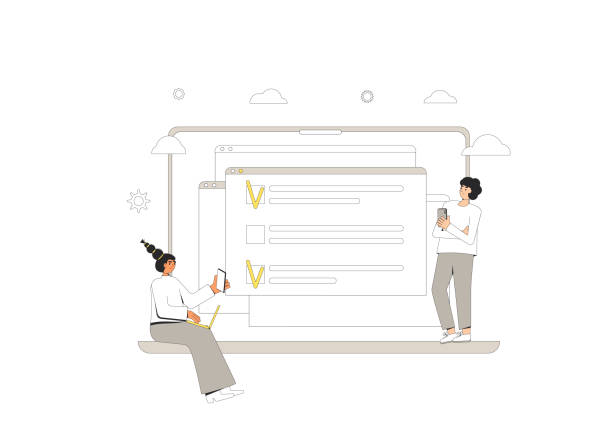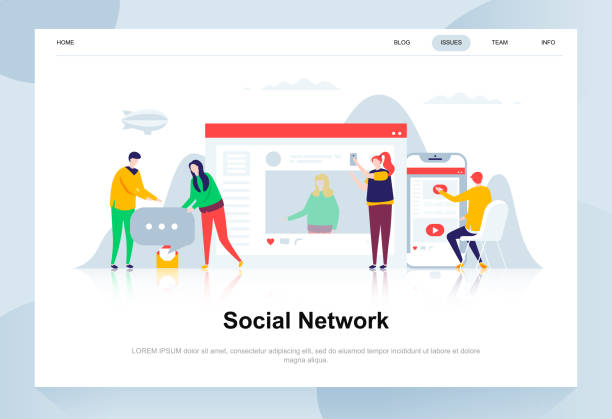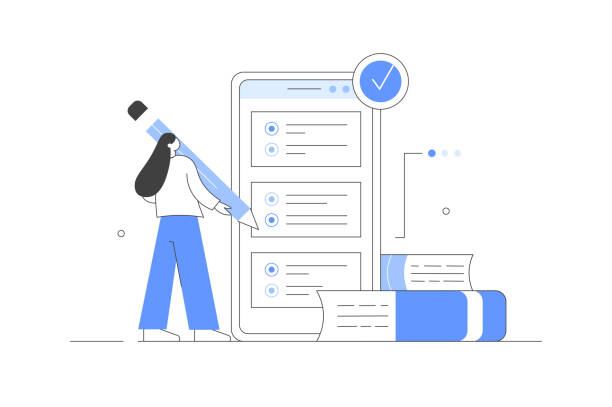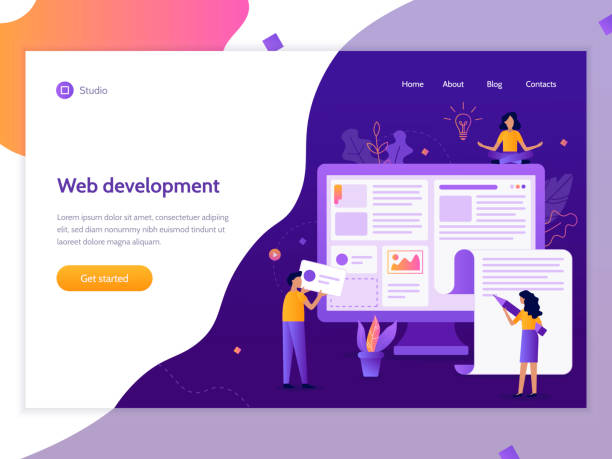Introduction and Importance of Secure Website Design

In today’s digital world, where a vast portion of our economic, social, and even personal activities take place on the internet and websites, secure website design is no longer a luxury option, but an undeniable necessity.
Every website, from a simple personal blog to large e-commerce platforms and online banks, is susceptible to #cyber_attacks.
A successful attack can lead to loss of sensitive data, identity theft, damage to business reputation, and even extensive financial losses.
Sustainable security in websites requires a comprehensive approach that starts from the very beginning of the web design process and continues throughout the website’s lifecycle.
This approach not only includes technical measures and secure coding but also involves educating and raising awareness among users and the development team.
Understanding the basic principles of cybersecurity and applying them in the web development process is a crucial step for protecting information and maintaining user trust.
This explanatory and educational section helps you to become more familiar with the importance of this topic and gain a deeper understanding of the challenges and solutions available in the field of secure website design.
Have you ever wondered which websites might put your personal information at risk?
Does your current website inspire the trust that potential customers should have in your business? If not, it’s time to have your professional and impactful corporate website with Rasaweb.
✅ Fully customized design tailored to your brand identity
✅ Increase lead generation and your business credibility in the eyes of customers⚡ Contact us for a free consultation!
Common Web Security Threats and Countermeasures

To achieve secure website design, identifying and understanding common web security threats is of paramount importance.
SQL Injection attacks are among the most common and dangerous attacks, through which attackers inject malicious SQL commands into the database to extract or manipulate sensitive information.
To counter this attack, using Prepared Statements and rigorous input validation is essential.
XSS (Cross-Site Scripting) attacks also allow attackers to inject malicious client-side code into web pages, which can lead to the theft of cookies, session information, and even account control.
Filtering and encoding user outputs is the primary solution for countering XSS.
The most specialized part in this area is a deep understanding of how these attacks work and implementing appropriate defensive mechanisms in the code and infrastructure.
Distributed Denial of Service (DDoS) attacks are carried out with the aim of taking a website offline by sending a massive volume of fake traffic; cloud solutions and powerful firewalls can be helpful in this regard.
Furthermore, Cross-Site Request Forgery (CSRF) and Phishing attacks are also considered serious threats, each requiring its own specific security measures.
Protecting user information and infrastructure requires a multi-layered and comprehensive approach that considers all these threats.
Practical guidance in this area includes using secure frameworks, employing up-to-date libraries, and conducting regular security audits.
Secure website design means anticipating attacks and building a robust defense.
Basic Principles and Secure Architecture in Web Design

Secure web architecture is the backbone of a secure website design and attack resistance.
These principles include separation of concerns, applying the Principle of Least Privilege for each system component, and not trusting user input.
Separation of concerns means that each part of the system performs only its specific task and does not have unnecessary access.
For example, the web server should not have direct access to the database with the highest privileges.
Furthermore, any user input must be carefully validated, filtered, and sanitized, as malicious inputs are the primary source of many vulnerabilities.
Using secure web frameworks like Django, Laravel, or ASP.NET Core, which provide built-in security mechanisms to counter common threats, can significantly increase website security.
Educational and explanatory content regarding the correct selection of architecture and security tools is crucial.
Proper server configuration, use of powerful firewalls, and application of security policies at the network and application levels are also integral parts of secure website design.
Below is a table of basic security checklists for developers:
| Security Item | Description | Status |
|---|---|---|
| Input Validation | Filtering and checking all user inputs | Done/Needs Review |
| Query Preparation | Using Prepared Statements to prevent SQL Injection | Done/Needs Review |
| Output Encoding | Encoding displayed data to prevent XSS | Done/Needs Review |
| Session Management | Using secure tokens and session expiration | Done/Needs Review |
| Access Control | Implementing strong authentication and authorization mechanisms | Done/Needs Review |
The Role of SSL/TLS Certificates and HTTPS Protocol

One of the most important pillars of secure website design in the current era is the implementation of the HTTPS protocol through the installation of SSL/TLS certificates.
HTTPS (Hypertext Transfer Protocol Secure) is essentially the secure version of the HTTP protocol that encrypts the communication between the user’s browser and the website server.
This encryption is performed by SSL (Secure Sockets Layer) and TLS (Transport Layer Security) certificates, with TLS being the newer generation of SSL.
When a user connects to an HTTPS website, all exchanged data – including login information, passwords, and credit card data – are encrypted, preventing eavesdropping by third parties.
This is especially vital for websites that exchange sensitive information, such as online stores, banks, and healthcare portals.
Without HTTPS, data transmitted over the network can be easily intercepted and read by attackers, which itself is a major security vulnerability.
In addition to data security, using HTTPS also has a positive impact on SEO (Search Engine Optimization) and website ranking in search engines.
Search engines like Google prefer HTTPS websites, and this is considered a ranking factor.
The most specialized aspect of this topic is choosing the correct type of SSL certificate (Domain Validated, Organization Validated, Extended Validation) and configuring it properly on the server to provide maximum security and trust.
The guidance to all website owners is to migrate to HTTPS as soon as possible and ensure that all website content is delivered through this secure protocol.
Does your company website perform as it should for your brand? In today’s competitive world, your website is your most important online tool. Rasaweb, specializing in professional corporate website design, helps you to:
✅ Build customer credibility and trust
✅ Convert website visitors into customers
⚡ Get a free consultation!
Password Management and Strong Authentication

Password management and implementing strong authentication mechanisms are two key components in secure website design.
Weak and guessable passwords are one of the most common security weaknesses in websites.
To counter this problem, websites should encourage users to use complex passwords (including uppercase and lowercase letters, numbers, and symbols) and set a minimum specified length for passwords.
Storing user passwords in an encrypted form and using strong hashing algorithms (such as bcrypt or Argon2) is crucial so that even if the database is breached, passwords are not accessible in raw form.
Practical guidance in this area includes not allowing direct password retrieval (only resetting), and implementing account lockout systems after multiple failed login attempts.
However, today, a password alone is not enough.
Multi-Factor Authentication (MFA) provides an additional layer of security where users, in addition to their password, need to provide a second factor (such as a code sent to their mobile or using authenticator apps) for login.
An analysis of breach statistics shows that many successful attacks are carried out by exploiting weak or stolen passwords.
Therefore, implementing MFA should be a priority for websites, especially for accounts that have access to sensitive information or high privileges in the system.
This not only enhances user security but also improves user trust in the platform and is a significant step towards secure and reliable website design.
Does your website support MFA and encourage users to use it?
Continuous Updates and Security Patches

One of the often-overlooked but vital aspects of secure website design is the commitment to continuous updates and applying security patches.
Software, whether server operating systems, CMS (like WordPress or Drupal), frameworks, programming libraries, or even plugins and themes, are constantly being developed and improved.
With each new update, not only are new features added, but known security vulnerabilities are also fixed.
The news aspect of this is that companies and the open-source community constantly release reports of new vulnerabilities and provide security patches for them.
Ignoring these updates means leaving the doors open for attackers who exploit publicly known vulnerabilities (CVEs).
For example, if a security flaw is discovered in an old version of WordPress and you don’t update it, your website can easily become a target for automated attacks.
This is an explanation of why security patch management should be an integral part of any website’s operational strategy.
Planning for regular updates, whether manually or using automated tools, is of great importance.
This requires continuous monitoring of security news and awareness of the latest vulnerabilities in the technologies your website uses.
Maintenance and updates in this way constitute a permanent security pact with your users and are an indispensable part of secure website design.
A stagnant website in terms of security is a website at risk.
Penetration Testing and Vulnerability Assessment

Penetration Testing and Vulnerability Assessment are two vital tools in the secure website design process that help identify weaknesses before attackers find them.
The most specialized aspect of this field is simulating real attacks on the system with the aim of discovering vulnerabilities and assessing its resilience.
Vulnerability assessment involves using automated tools to scan systems and applications to identify known vulnerabilities.
These tools can quickly identify thousands of potential weaknesses in code, server configurations, or software dependencies.
In contrast, penetration testing is a more manual and targeted approach performed by security professionals (Pentesters).
They use techniques and tools employed by real hackers to identify specific weaknesses and more complex attack scenarios.
An analysis of these test results helps the development team understand and address the weaknesses.
This process should be conducted periodically and also after any significant change in the website’s architecture or code.
Penetration test results can include detailed reports about vulnerabilities, their risk level, and practical solutions to address each one.
Investing in penetration testing means investing in the long-term security of the website and is a firm step towards secure and reliable website design.
Do you know how resilient your website is against targeted attacks?
| Security Test Type | Main Goal | Common Tools |
|---|---|---|
| Vulnerability Assessment | Identifying known vulnerabilities with automated scanning | Nessus, OpenVAS, Acunetix |
| Penetration Testing (Black-box) | Simulating an attack without internal system knowledge | Kali Linux, Metasploit, Nmap |
| Penetration Testing (White-box) | Simulating an attack with full access to code and infrastructure | SAST tools, IDE plugins |
| Code Security Review | Manual and automated code review to discover security flaws | SonarQube, Bandit, ESLint |
Backup and Disaster Recovery Planning

No secure website design is complete without a robust backup plan and a comprehensive Disaster Recovery Plan.
Even the most secure systems can be vulnerable to human errors, hardware failures, natural disasters, or sophisticated cyber attacks.
Regular data backup, including website source code, database, and all critical files, is the first line of defense against data loss.
Practical guidance is that backups should be performed automatically and regularly (daily, weekly, or monthly depending on the data change rate) and stored in secure locations separate from the main server; it is best to use cloud storage or offline servers.
However, merely backing up is not enough.
A disaster recovery plan is a comprehensive document that outlines the necessary steps to restore a website to operational status after a destructive incident.
This plan should include details such as responsibilities, timelines, a list of all required systems and software, and methods for accessing backups.
Another explanation in this regard is the importance of testing recovery plans.
A disaster recovery plan that has never been tested is as worthless as no plan at all.
Conducting periodic recovery tests helps ensure the plan’s effectiveness and up-to-dateness, revealing any weaknesses or issues before a real disaster occurs.
Crisis preparedness is an essential part of comprehensive cybersecurity and complements all efforts for secure website design and increasing website resilience.
Do you have a plan to recover your website in case of a problem, and have you tested it?
Did you know that a weak corporate website loses you many opportunities daily? Solve this problem forever with professional corporate website design by Rasaweb!
✅ Create a powerful and reliable image of your brand
✅ Targeted attraction of new customers and increased sales
⚡ [Get a free website design consultation]
User Awareness and Cybersecurity Culture

Alongside all the technical and architectural measures taken for secure website design, the role of user awareness and fostering a strong cybersecurity culture is vital.
Many successful cyberattacks occur through social engineering and deceiving users, not necessarily by exploiting technical vulnerabilities.
Phishing, spear phishing, and vishing attacks are examples of these attacks, whose aim is to trick users into disclosing sensitive information or clicking on malicious links.
The thought-provoking content in this area is: how aware are users really of the existing risks? Entertaining yet educational, producing educational content for users on how to identify suspicious emails, the importance of using strong and unique passwords, and the dangers of clicking on unknown links, is highly effective.
Websites can increase their users’ awareness levels by providing clear warning messages, short tutorials during registration or login, and even interactive games or quizzes.
The role of developers in this regard is not limited to secure coding, but also includes incorporating strategies for enhancing user awareness into their User Interface (UI) and User Experience (UX) design.
For example, displaying connection security status (HTTPS), providing security tips in login forms, or mandatory activation of two-factor authentication, can all contribute to increasing user security.
Secure website design is not just about code, but also about people and their interaction with technology.
Fostering a cybersecurity culture among users is a long-term investment in the website’s stability and trustworthiness.
The Future of Secure Website Design and New Trends

Secure website design is a dynamic and evolving field, constantly facing new threats and emerging technologies.
An analysis of current trends shows that cyberattacks are becoming more sophisticated and targeted, utilizing artificial intelligence and machine learning to identify vulnerabilities and even conduct automated attacks.
In the future, we will see an increased focus on the Zero Trust security model, where no user or device, even within the organization’s network, is trusted by default, and every access must be continuously authenticated and authorized.
This approach means increased granularity in access control and continuous monitoring of all activities.
Additionally, Blockchain technology may also play an increasing role in improving data security and authentication, especially in systems requiring transparency and decentralization.
News of developments in web standards and new encryption protocols also attests that the cybersecurity community is constantly striving to increase system resilience.
Web developers must keep themselves updated with these new trends and expand their knowledge in future-oriented security technologies.
Cybersecurity is no longer just about defense, but also about anticipating and preparing for unknown threats.
Secure website design in the future will require a more proactive and comprehensive approach that not only covers existing vulnerabilities but is also prepared to counter threats yet to be discovered.
This is a big but exciting challenge for the web development community.
Frequently Asked Questions
| No. | Question | Answer |
|---|---|---|
| 1 | What does secure website design mean? | Secure website design refers to a set of measures and methods employed to protect a website against cyberattacks, unauthorized access, data breaches, and other security threats. Its goal is to maintain the confidentiality, integrity, and availability of information. |
| 2 | Why is website security important? | Website security is vital for maintaining user trust, protecting sensitive information (such as personal and financial data), preventing financial losses, preserving brand reputation, and complying with legal regulations (such as GDPR). A security breach can lead to customer loss and heavy fines. |
| 3 | What are some of the most common security attacks against websites? | Common attacks include SQL Injection, XSS (Cross-Site Scripting), CSRF (Cross-Site Request Forgery), Brute Force, DDoS attacks, Broken Authentication, and Missing Function Level Access Control. |
| 4 | What is the role of SSL/TLS certificates in website security? | SSL/TLS certificates (which lead to HTTPS addresses) are used to encrypt data exchanged between the user and the website server. This prevents eavesdropping or manipulation of sensitive information, such as passwords and credit card details, during transmission and verifies the website’s authenticity. |
| 5 | How can SQL Injection attacks be prevented? | To prevent SQL Injection, Prepared Statements or ORM (Object-Relational Mapping) with validated parameters should be used. Additionally, thorough filtering and validation of user inputs (Input Validation) and applying the principle of least privilege in the database are essential. |
| 6 | What is HTTP Strict Transport Security (HSTS) and how does it help security? | HSTS is a web security policy that tells browsers to only load a website over an HTTPS connection, even if the user enters the address with HTTP. This prevents downgrade attacks and cookie theft on public Wi-Fi networks. |
| 7 | What is the importance of regularly updating software and plugins for website security? | Regularly updating the Content Management System (CMS), plugins, themes, and other software components of a site is crucial for addressing discovered security vulnerabilities. Developers continuously release security patches, and failing to update can leave the site vulnerable to known attacks. |
| 8 | What measures can be taken to increase the security of the website’s administration section (admin panel)? | Changing the default admin panel path, using strong passwords and two-factor authentication (2FA), restricting access to specific IPs, using CAPTCHA on login pages, monitoring logs, and continuous CMS updates are among these measures. |
| 9 | Why is filtering and validating user inputs (Input Validation) important? | Filtering and validating inputs helps prevent the injection of malicious code or unauthorized data through forms, URLs, or other user input sections. This prevents attacks such as XSS and SQL Injection that exploit invalid inputs. |
| 10 | Name some common tools or services for checking and enhancing website security. | Tools such as Web Application Firewalls (WAF), vulnerability scanners (e.g., Acunetix, Nessus), Intrusion Detection and Prevention Systems (IDS/IPS), CDN services with security features (e.g., Cloudflare), and periodic Penetration Testing can enhance website security. |
And other services by Rasaweb Advertising Agency in the field of advertising
Smart Conversion Rate Optimization: Revolutionize user engagement with precise audience targeting.
Smart Brand Identity: A fast and efficient solution for improving SEO ranking with a focus on marketing automation.
Smart Content Strategy: Professional optimization for campaign management using attractive UI design.
Smart Sales Automation: Transform online growth with custom programming.
Smart Brand Identity: An innovative platform to improve click-through rates with intelligent data analysis.
And over a hundred other services in the field of internet advertising, advertising consulting, and organizational solutions
Internet Advertising | Advertising Strategy | Advertorials
Resources
- Comprehensive article on secure website design
- Why is website security essential for your business?
- Comprehensive guide to website security
- The importance of website security in online businesses
? Are you looking for significant growth for your business in the online space? Rasaweb Afarin, with unparalleled expertise in digital marketing, from fast and optimized website design to comprehensive SEO strategies and content creation, is your complete solution for visibility and attracting more customers.
📍 Tehran, Mirdamad Street, next to Central Bank, Southern Kazeroun Alley, Ramin Alley, No. 6




